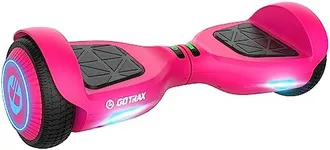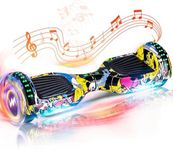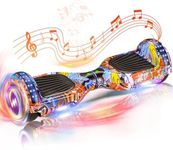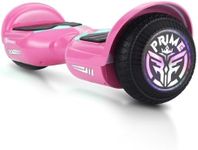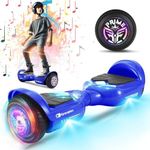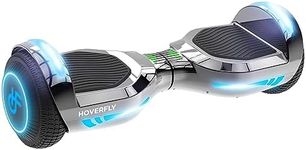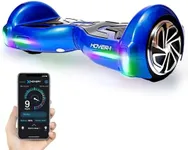Buying Guide for the Best Hoverboards
Choosing the right hoverboard can be a fun process if you know what to look for. Hoverboards, also known as self-balancing scooters, come in a variety of styles and with different features. The best way to pick one is to think about where and how you plan to use it, your experience level, and your personal preferences for things like speed and portability. Understanding the key specifications will help you match a hoverboard to your needs and ensure a safe and enjoyable ride.Wheel SizeWheel size refers to the diameter of the hoverboard's wheels, usually measured in inches. This is important because it affects how smooth your ride will be and what types of surfaces you can handle. Smaller wheels (around 6.5 inches) are best for smooth, flat surfaces like indoor floors or paved sidewalks. Medium wheels (about 8 inches) offer a balance and can handle some bumps or cracks. Larger wheels (10 inches or more) are better for rougher terrain, grass, or gravel. If you plan to ride mostly indoors or on smooth pavement, smaller wheels are fine. For outdoor use on uneven ground, go for larger wheels.
Maximum SpeedMaximum speed tells you how fast the hoverboard can go, usually measured in miles per hour (mph) or kilometers per hour (km/h). This is important for both safety and fun. Lower speeds (up to 6 mph) are safer for beginners and younger riders. Mid-range speeds (7-9 mph) are good for most users who want a balance of safety and excitement. Higher speeds (10 mph or more) are best for experienced riders who want a thrill. Think about your comfort level and where you'll be riding—if you're new or riding in crowded areas, a lower speed is safer.
Range (Battery Life)Range refers to how far the hoverboard can travel on a single charge, usually measured in miles or kilometers. This is important if you plan to use your hoverboard for longer trips or commutes. Shorter ranges (up to 6 miles) are fine for quick rides or play. Medium ranges (7-12 miles) suit most users for daily fun or short commutes. Longer ranges (over 12 miles) are best if you want to travel farther without recharging. Consider how far you want to go in one session and pick a range that matches your needs.
Weight CapacityWeight capacity is the maximum weight the hoverboard can safely carry, usually listed in pounds or kilograms. This is important for safety and performance. Lower capacities (up to 150 lbs) are suitable for children and lighter riders. Mid-range capacities (151-220 lbs) fit most teens and adults. Higher capacities (over 220 lbs) are needed for heavier riders. Always choose a hoverboard that supports your weight to ensure safe operation and avoid damaging the device.
Safety CertificationsSafety certifications, like UL 2272, indicate that the hoverboard has passed tests for electrical and fire safety. This is very important because early hoverboards sometimes had battery issues. Always look for a hoverboard with recognized safety certifications to ensure it meets safety standards. This is a must-have for all users, regardless of age or experience.
Portability (Weight of Hoverboard)The weight of the hoverboard affects how easy it is to carry when you're not riding. Lighter hoverboards (under 20 lbs) are easier for kids or anyone who needs to carry it often. Heavier models (over 25 lbs) may be sturdier but are harder to transport. If you need to carry your hoverboard up stairs or on public transport, consider a lighter model.
Additional FeaturesSome hoverboards come with extra features like Bluetooth speakers, LED lights, or mobile app controls. These can make your ride more enjoyable or add convenience, but they aren't essential for everyone. If you like music or want to ride at night, look for these features. Otherwise, focus on the basics.
